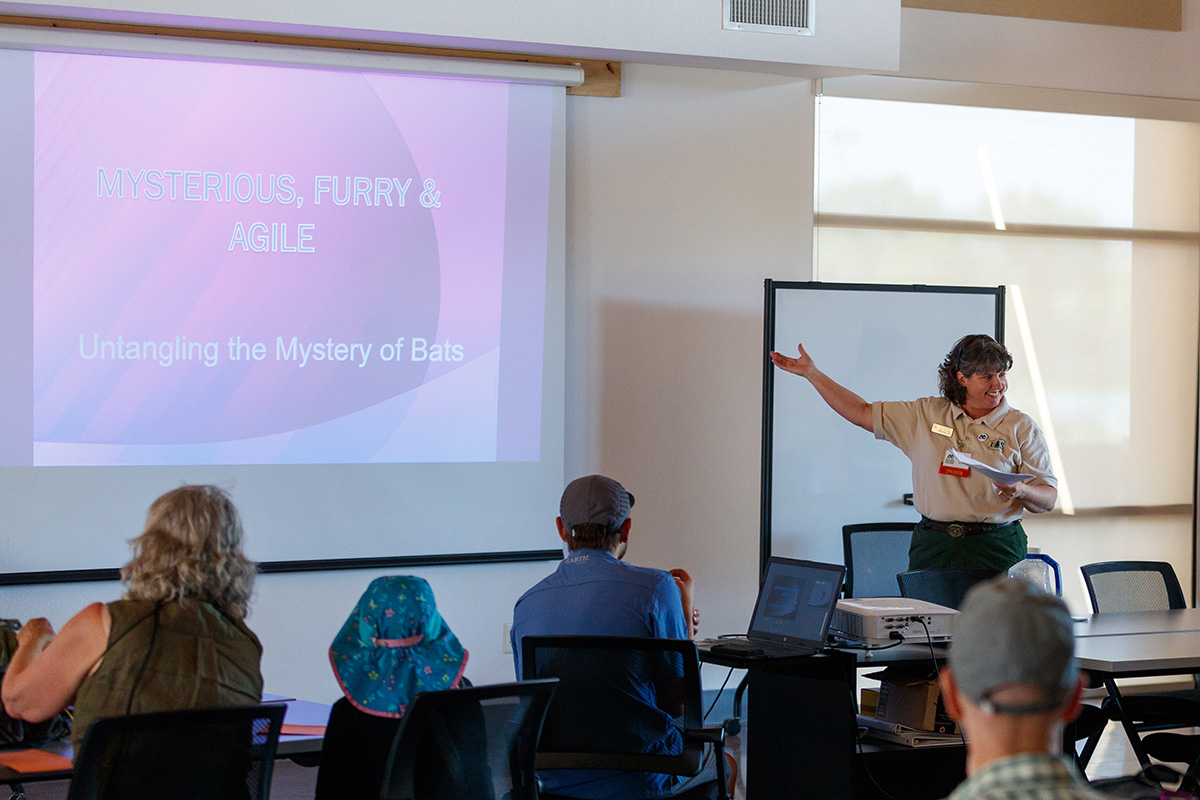
Janie Agyagos of the district wildlife staff for the Coconino National Forest presented a lecture titled “Mysterious, Furry and Agile: Untangling the Mystery of Bats” at the Verde Valley Birding and Nature Festival on April 27.
Agyagos spoke about how she discovered that most people have mixed or negative feelings about bats, and expressed a desire to educate people about animals that are vital to the desert ecosystem.
Bats are the only true flying mammals and have evolved ways to be active at night, such as echolocation. Agyagos observed that the 1,300 species of bats worldwide make up about 20% of all mammals, while almost 250 additional species have gone extinct. Arizona has a very high level of bat diversity; the state is home to 28 species, 24 of which have been observed in the Verde Valley.
Agyagos reminded her audience that bats exhibit a great deal of unnoticed diversity, mainly because they are most often spotted at night. Bat fur may be tricolored, silver tipped or spotted, and bat species around the globe have evolved unique facial variations adapted to their environments and diets.
The Verde Valley’s native bat species include the canyon bat, which is the smallest bat in the valley. The spotted bat is very rare but can be identified by its large pink ears and black and white spots. These bats are high flyers and can cover 12 miles in a single night. The pallid bat has palomino coloration, a pig-like snout and a musky smell. The large brown bat has dog-like canines for eating insects.
Bats need roosts, and can make themselves at home in the expansion joints of bridges, caves, sinkholes, under rocks and in tree holes, stumps or bark. Their legs are rotated 180 degrees backwards to allow them to hang in comfort.
The primary reason for bat population decline is roost disturbance. Agyagos claimed that sounds such as whispering, Velcro and zippers can disturb bats while in their roosts, especially during torpor or hibernation. Multiple disturbances will cause bats to abandon their roost.
All of Arizona’s bats are insectivorous, but worldwide their diets may include fruit, nectar, blood, fish and small mammals.
Agyagos described a year in the life of a bat, which begins in spring when bats are either waking from a state of torpor or embarking on a return migration. In summer, bat populations sex-segregate themselves; females go to maternity roosts and males go to bachelor roosts. Mating occurs in fall, followed by migration if the species does not hibernate. Migration or hibernation take up a bat’s winter. If bats are disturbed during hibernation, they can burn through their fat reserves and starve to death.
Scientists use both passive and active survey methodologies to study bats. Passive measurements can include stain and guano measurements, exit counts to determine how many bats are in a roost, video recording and thermal imaging. Sonograms can be used as bat detectors and can record call frequencies that can be interpreted to identify a species.
Active survey measures include radio telemetry, which involves gluing a lightweight radio to the bat to be able to track it. Scientists also use very fine mist nests to capture bats without harming them.
One of the things conservationists in Arizona look for when studying bats is wing damage resulting from white nose syndrome. This disease is caused by a fungus that erodes wing membranes while bats are hibernating and usually occurs in humid roosts packed with lots of bats. While the fungus has been detected in Arizona, the disease has not been, most likely due to the shorter hibernation period in the Southwest, the lack of humidity and greater amounts of space for bats to spread out in their roosts.
Bats are also affected by pesticides, loss of foraging and roosting habitats, collisions with vehicles and the hazards of migration.
Agyagos debunked the idea that bats are often rabid. She stated that less than 1% of bats actually have rabies and that bats are not common vectors of disease.
Bats are very important to the health of an ecosystem. They consume a significant number of insects each night, providing free pest control. They also pollinate many useful plants, such as agave, and their guano can be used as fertilizer, as well as supporting complex cave ecosystems in situ. They spread seeds and play a key role in the food chain. Vampire bats have a compound in their saliva that prevents blood coagulation, and studies of bat echolocation have influenced human aviation and sonar technology.
Residents of the Verde Valley can help bats by educating themselves about bats, protecting roosts and habitats, providing artificial bat houses and making their houses safely bat-exclusive.